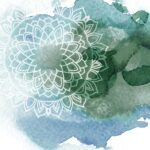
Wintering with the Yoga Sutras
Navigating Inner Landscapes through Yogic Wisdom and Journaling Practices - By Rebecca Adams
Reading time: 4 minutes
If you're in the northern hemisphere, you've already experienced that shift toward the darkest night of the year and the chill that this turn away from the sun brings. On the one hand, this season brings awe and excitement as leaves burst into a brilliant palette before falling to the ground, sunsets take on softer hues, and holiday traditions keep us inspired and distracted.
Yet, on the other hand, this particular seasonal transition can bring a subtle sense of dread and escapism, as Earth's natural cycles invite us to release all those external orientations and turn inward. Regardless of the extent of our practice and purity, we often find that our inner landscape is not so picturesque as firey golden leaves and hazy mornings. In many cases, we find exactly what our worldly-mindedness has been running from.
Yogash-citta-vrtti-nirodhah
The yoga sutras of Patanjali provide wisdom appropriate for any time and space. Still, their overarching point, captured like a climax in only the second sutra, is particularly apt for this season: Yogash-citta-vrtti-nirodhah. Yoga is control of thought waves in the mind. Within this short sutra, the author provides both the outcome of yoga, or union, as well as the clearcut path to getting there. Moreover, it cites the problem.
Stilling the Waves
The problem is uncontrolled thought. Citta vrttis, or mental fluctuations, are like waves that flit tirelessly across a lake on a windy day. The wind is a natural creation; all life is based on movement and three primordial qualities whose moving interplay creates all that is. These three primordial qualities, or gunas, are sattva - the quality of purity; rajas - the quality of movement; and tamas - the quality of inertia. Together, the gunas inform the building blocks of creation.
The templates they create are the differing winds of experience. What those winds 'call to mind' or bring to the surface of our awareness and experience depends on our constitutions, conditioning, unconscious impressions, memories, and desires. The natural instability of our mental nature and the karmic content waiting to emerge when riled up blend to keep us in a state of inner chatter and chaos.
A commonly cited metaphor explaining yogash-citta-vrtti-nirodhah brings the choppy thought waves that disturb the waters of our psyche into a landscape scene that also includes a mountain. The mountain, which rises majestically from the edge of the body of water, is Consciousness. A still mind - unmoving water - reflects that mountain clearly. A fluctuating mind - citta vrtti - cannot clearly capture the true image. In either case, our mind is the water.
It is but a reflector of Consciousness, not Consciousness itself. It is a vessel through which the light of Consciousness shines. Yet the more we still the waves of our mind, heal the latent impressions that project through us as us and make our vessels crystalline like smooth water on a calm day, the more we can purely transmit the luminous image of Consciousness. We become sattvic. We become less ‘me’ and more ‘It.’ We become less refraction and more revelation.
The perceptions and practices enumerated in Patanjali’s four books of yoga sutras all exist to support this one embodied goal of citta-vrtti-nirodhah, the cessation of mental fluctuations. The clear-sightedness, or viveka khyati, that results reveals the water as separate from the mountain and the vessel, or prakrti, as distinct from the Consciousness, or purusha, that animates and witnesses Creation through it.
Embracing Winter, Acknowledging Our Roots
Controlling thought to reflect the mountain through internally clear waters does not equate to repressing it. More often than not, the thoughts that arise in our mind reveal our orientations, be they focused or distracted; our values, be they core or fleeting; and our hangups, all unresolved, egoic misperceptions. Thoughts are the meat of our ignorance and that with which we create. Everything begins in the mind.
Controlling thought waves, then, is a two-fold discipline.
- First, it is witnessing from the state of neutral observer that the choppy waters of thought are self-creators. It is excavating the roots of these thoughts and identities, actively uprooting them so that no further thoughts of that template will blossom into karma, or action. Baba Hari Dass called this deep extraction roasting the seeds of action, for roasted seeds can no longer bear fruit.
- The second element of the two-fold discipline of yogash-citta-vrtti-nirodhah is actively stilling the waves of thought moving over the surface of deep consciousness. This feat becomes easier once our inner grounds have been weeded.
Weeding in Winter
Late fall and early winter are ruled by vata, while deep winter is ruled by kapha. Vata is the energetic quality of movement and transportation and is associated with the ether and air elements. It is cool, dry, mobile, subtle, light, and rough. Kapha, associated with water and earth, is slow, heavy, cool, moist, steady, and oily.
The qualities of vata and kapha at this time of year manifest both physically and mentally. When combined with the barren, vata- and kapha-vitiating frigidness outside, the personal shadows and constructs that often rear their ugly heads in winter create a hologram that not too many of us love to traverse. It can be tamasic and loaded or frenetic and anxiety-inducing.
Nevertheless, at this time on the planet, taking a good hard look within at what we carry and what we share is vital. For anyone who purports to practice yoga, radical self-honesty is no longer optional. Our unhealed wounds - be they of privilege or oppression - are leaking, and we are poisoning the worldy.
That we may be fortunate to not be the primary victims of this collective toxicity does not make its reality any less stark or its existence any less our doing. Because it is more challenging to get honest with the cold parts of ourselves and our collective hologram than to run away, it is essential that we doula ourselves through this process by getting intimate.
Getting Intimate
There are at least two primary procedures for which journaling is beneficial. The first is channeling. Also referred to as “creator state,” channeling into writing is a process that occurs when we are aligned with our higher levels and capable of capturing from the universal Mind, or mahat, information and instruction appropriate to our personal mission but not personally conjured.
This type of connected inner work is often associated with the height of spring and nascent summer when personal density has been alchemically heated out of the body through tapas, and there is space for universal abundance to be tapped.
The second practice for which journaling is well-suited is intimacy. Intimacy, in this case, is also referred to as "tend and befriend.” It is the practice of leaning into our personal heart's feelings, desires, grief, and truths. Journaling in this way - whispering to the heart, "Tell me, beloved” - creates trust between ourselves and our Self. It is at once a love letter and a confession.
The romance of honesty, when we develop the courage to cultivate it, shows us how deeply we want to grow and become better, repent and be forgiven, love and be loved.
In the quiet, dark winter hours, journaling to give our hearts a voice - thus spending quality time with our shadows, which are really only our previously cast-out parts - becomes a most sacred, cherished ritual. We begin to understand the power and beauty of germination.
We recognize that, for all the death happening within and without at this time, new growth is forming. As we learn that our inner creates our outer, we make peace with tending to the waves within and give thanks to the Earth for providing us natural opportunities to do so.





